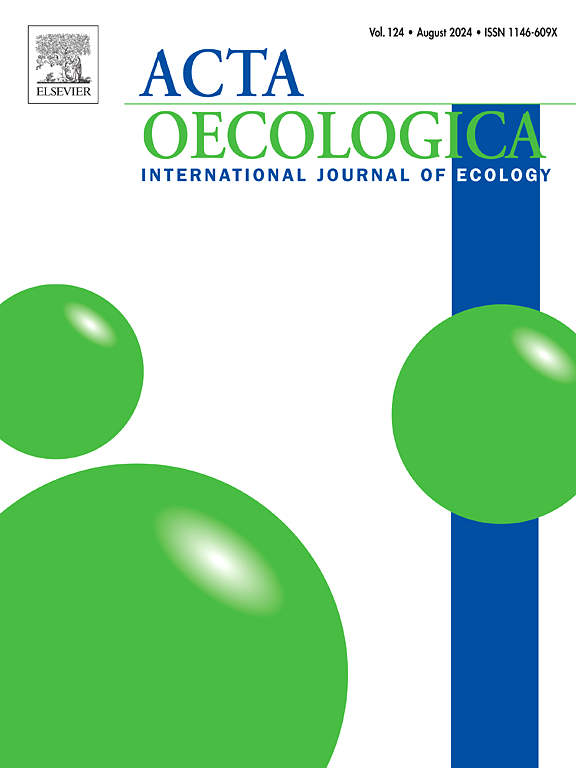牛油果单一栽培的扩张威胁到墨西哥中部帝王蝶的越冬栖息地
IF 1.3
4区 环境科学与生态学
Q3 ECOLOGY
Acta Oecologica-International Journal of Ecology
Pub Date : 2025-09-01
DOI:10.1016/j.actao.2025.104116
引用次数: 0
摘要
牛油果已成为墨西哥中部高地的主要种植作物。然而,牛油果的单一栽培引发了针叶林的减少,甚至在保护区内也是如此,比如帝王蝶生物圈保护区,那里是迁徙的帝王蝶(Danaus plexippus Linnaeus)越冬的地方。本研究模拟了2006年至2024年牛油果单一栽培的扩张,以及在当前气候和气候变化(低排放和高排放)情景下,松树、混合针叶林和神杉林的牛油果适宜种植区域。因此,到2024年,1345公顷的鳄梨果园覆盖了保护区;其中大部分来自以前传统农田的改造,其中337公顷来自松栎林。在当前气候条件下,适宜种植的面积为5076公顷,其中鳄梨果园已占27%,森林覆盖率为50%。在低排放情景下,到2050年和2070年分别有3576公顷和5133公顷土地适合种植;在高排放情景下,到2050年将达到5038公顷,到2070年将达到10395公顷。在这两种气候变化情景中,适宜的地区都向更高的海拔移动。松栎林受牛油果单一栽培扩大的影响最大。尽管作为帝王蝶越冬栖息地的神圣冷杉和混合针叶林没有受到直接影响,但由于花蜜来源减少和新果园使用杀虫剂,预计鳄梨种植的扩大构成了威胁。因此,保护针叶林和更好的鳄梨栽培方法对于确保这种迁徙现象至关重要。本文章由计算机程序翻译,如有差异,请以英文原文为准。
Expansion of avocado monoculture threatens the overwintering habitat of monarch butterflies in central Mexico
Avocado (Persea americana Mill.) has become the main cultivated crop in the highlands of central Mexico. However, avocado monoculture has triggered the loss of conifer forests, even within protected areas, such as the Monarch Butterfly Biosphere Reserve that hosts the overwintering sites of the migratory monarch butterflies (Danaus plexippus Linnaeus). This study modeled avocado monoculture expansion from 2006 to 2024 and suitable areas for avocado cropping under current climate and climate change (low and high emissions) scenarios in pine-oak, mixed-conifer, and sacred fir forests. As a result, 1345 ha of avocado orchards covered the protected area in 2024; most came from the conversion of former traditional croplands and 337 ha from pine-oak forests. Under the current climate, suitable areas were found in 5076 ha, of which avocado orchards already occupied 27 % and 50 % covered by forest. Under the low-emission scenario, 3576 ha were suitable by 2050 and 5133 ha by 2070; under the high-emission scenario, they amounted to 5038 ha by 2050 and 10,395 ha by 2070. In both climate change scenarios, suitable areas moved to higher elevations. Pine-oak forest was the most affected by the expansion of avocado monoculture. Although sacred fir and mixed-conifer forests, the overwintering habitats of monarch butterflies, were not directly affected, the projected expansion of avocado cropping represents a threat due to the reduction of nectar sources and the use of pesticides in new orchards. Therefore, the preservation of conifer forests and better avocado cultivation practices are crucial to ensure this migratory phenomenon.
求助全文
通过发布文献求助,成功后即可免费获取论文全文。
去求助
来源期刊
CiteScore
3.60
自引率
0.00%
发文量
57
审稿时长
>0 weeks
期刊介绍:
Acta Oecologica is venue for the publication of original research articles in ecology. We encourage studies in all areas of ecology, including ecosystem ecology, community ecology, population ecology, conservation ecology and evolutionary ecology. There is no bias with respect to taxon, biome or geographic area. Both theoretical and empirical papers are welcome, but combinations are particularly sought. Priority is given to papers based on explicitly stated hypotheses. Acta Oecologica also accepts review papers.

 求助内容:
求助内容: 应助结果提醒方式:
应助结果提醒方式:


